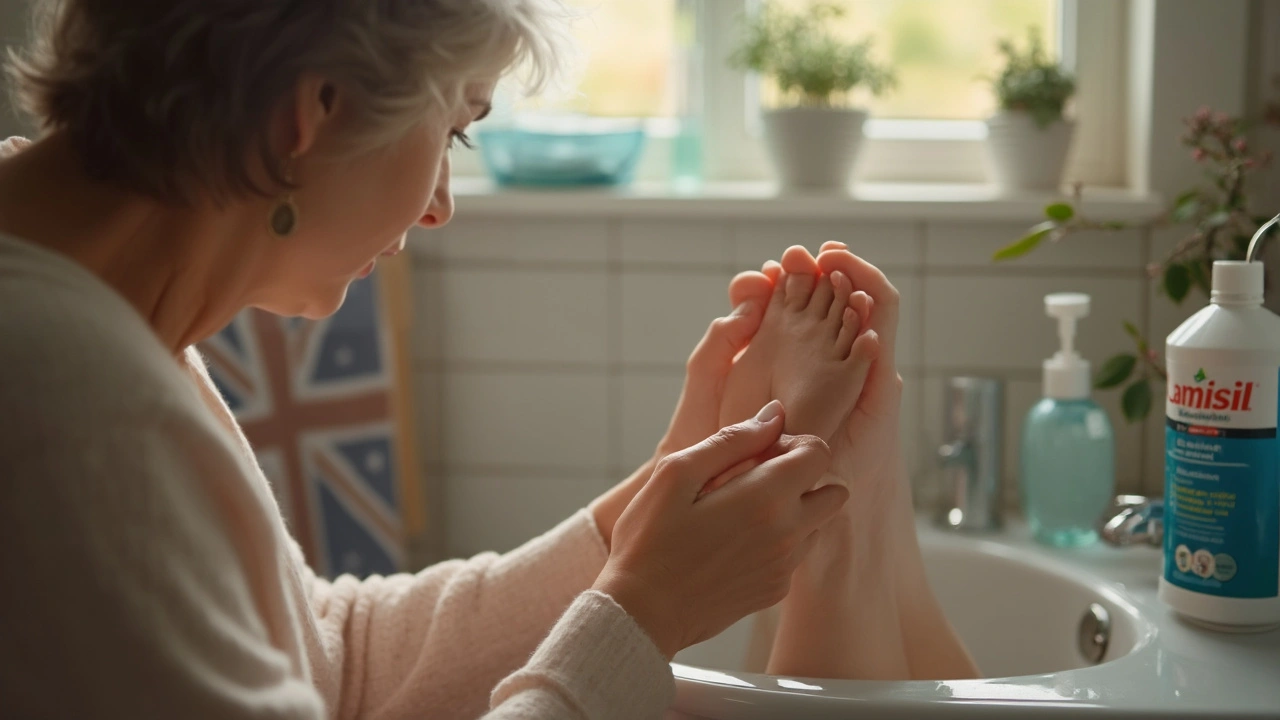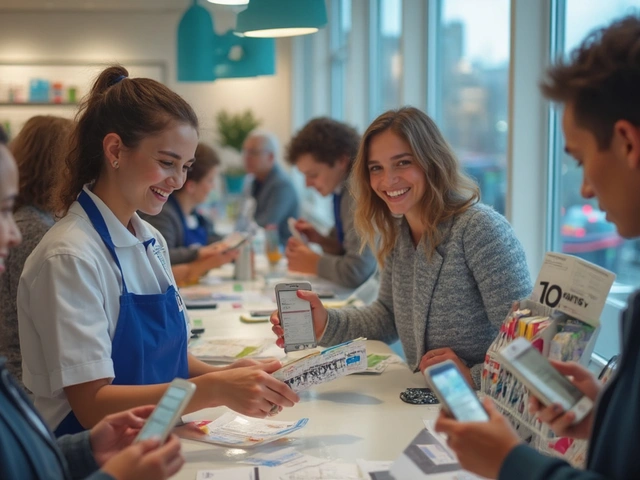Fungal infections can sneak up on anyone—even the most careful among us. They show up, sometimes with just a bit of itching or flaking at your feet, and before you know it, half your toenail looks like it’s been invaded by aliens. The search for something that actually works can feel like playing whack-a-mole, which is exactly why people turn to big-name meds like Lamisil.
What Exactly Is Lamisil and How Does It Work?
Lamisil isn’t just a random cream you'd find in your grandma’s medicine cabinet. It's the go-to name for terbinafine, a real powerhouse antifungal. Doctors have been prescribing Lamisil since the early ’90s, and it’s used all over the world. You can get it as a cream, gel, spray, or pill, depending on where the fungus is playing hide-and-seek. Honestly, when you see how stubborn athlete’s foot or toenail fungus can get, you understand why pharmacists always have it on the shelf.
The secret sauce? Lamisil doesn’t just mess with the fungus—it crushes the stuff. Fungi have these special fats in their cells that keep them alive. Lamisil blocks the enzyme responsible for making those fats, basically starving the fungus from the inside. That means it can wipe out all sorts of infections: athlete’s foot (the technical name’s tinea pedis), jock itch (tinea cruris), ringworm (tinea corporis), and those dreaded thick, yellowed toenails (a.k.a. onychomycosis). Seriously, the number of people dealing with nail fungus is wild—studies put it at about 10% of the world’s population, and this number jumps if you’re over 60.
Most over-the-counter stuff works for mild cases, but if your infection’s been hanging around like a bad roommate, Lamisil is probably where you’ll end up. Just a heads up, though: oral Lamisil is prescription-only in the U.S., since it’s strong enough to need some watching over by your doc. Fun fact—the topical forms (cream, gel, spray) are available without a prescription.
Lamisil doesn’t just stop fungus; it’s fast. Most users notice improvement within a week for athlete’s foot or ringworm. Toenail fungus is a beast and takes longer—up to 12 weeks or more, because nails grow at a glacial pace. A good tip? Don’t ditch the treatment halfway or you might see the infection pop straight back up.
Common Uses and Who Should Reach for Lamisil
If your feet sport peeling skin, itchy red rashes, or your nails look sad and thick, Lamisil could be your answer. Let’s break down some of its common uses so you know when to apply the stuff—and when to see a doctor.
- Athlete’s foot: The classic burning, cracked, itchy skin between your toes. The topical forms of Lamisil slam this infection fast, sometimes in as little as a week.
- Ringworm: Yes, the “worm” part is misleading. It’s just a fungus making circles on your skin. Lamisil cream destroys it.
- Jock itch: If you ever had an angry-looking rash in your groin area, this is probably it. Lamisil can clear things up, but use it for the full recommended time, even if your skin looks “normal” after a few days. Fungus fools you that way.
- Toenail or fingernail fungus: If your nail is yellowed, crumbly, or thick, Lamisil tablets are one of the few medicines that can actually kick the infection out. It requires a prescription and a bit of patience—usually a 6- to 12-week course.
For skin issues, you rub a thin layer of the cream onto clean, dry skin, usually once or twice a day. For nails, you take a pill. And oh, here’s something most people miss: wash your hands before and after putting it on, unless you’re looking to spread fungus elsewhere. Nobody wants athlete’s hand.
Children under 12 usually need a doctor’s advice before using Lamisil. For older adults—especially those with liver or kidney problems—it’s smart to check with your doc before starting oral Lamisil. The same goes if you’re pregnant or breastfeeding. Worth knowing: studies haven’t shown the topical cream to be harmful in pregnancy, but the oral tablet gets more scrutiny.
For anyone into numbers, check this out—the cure rate for mild to moderate athlete’s foot with Lamisil cream is about 80% in published studies. For nail fungus, oral Lamisil beats out its main rival, itraconazole: it brings cure rates up to 70% for toenails and 79% for fingernails in large trials. Just remember, using it right makes all the difference.

Side Effects, Warnings, and What Most People Don’t Realize
Every medicine has its quirks, and Lamisil is no exception. If you slap on the topical stuff, most people just feel a little burning or itching—maybe a hint of dryness. That’s the fungus dying off, not your skin reacting weird. If it gets red, swollen, or starts oozing, stop and see a doctor.
The tablet, though, deserves a bit more respect. Because it lands in your bloodstream, it can mess with your digestive system (think nausea, diarrhea, upset stomach), your sense of taste (yep, food tasting like cardboard is a thing), or cause rare changes to your liver. You’ll sometimes see Lamisil users warned to check for signs like yellowish eyes, dark pee, or unexplained fatigue—those could mean liver trouble, so don't shrug them off.
Data from recent years shows that serious side effects—like liver failure—are super rare, with an estimated 1 in a million users affected. But doctors don’t take chances. That’s why before starting the oral route, you'll likely get baseline liver tests, and maybe more if you’re on it for months.
Here’s the wild part—there’s a genetic quirk called CYP2D6 metabolism: some people process Lamisil faster or slower than others, which can change how strong the side effects are. Your doc might talk about this if you’ve had weird reactions to any meds in the past.
Alcohol won’t mix well with oral Lamisil. You’re already giving your liver some extra work, so adding drinks isn’t a brilliant move. Also, if you take a lot of meds that get processed by the liver (think antidepressants, blood pressure meds), let your doctor know so you don’t get a surprise drug clash.
| Lamisil Use | Common Side Effects | Serious (Rare) Side Effects |
|---|---|---|
| Topical (Cream, Gel, Spray) | Redness, Itching, Burning | Rash, Hives, Severe Allergic Reaction |
| Oral (Tablet) | Headache, Stomach Upset, Loss of Taste | Liver Damage, Severe Skin Reaction |
If you’re taking Lamisil for nails, don’t expect a miracle overnight. The fungal part dies early on, but your nail grows super slow—it can take a year for a clear one to fully replace the gnarly old one. Some folks make the mistake of tossing their shoes or socks in the laundry and thinking that’s enough. They forget fungus can hang around in your shoes, so you might need an antifungal spray for your footwear, too. Keeps reinfection at bay.
Tips for Using Lamisil and Preventing Fungal Recurrence
Lamisil is powerful, but there’s a bit of an art to using it right. First, make sure that whatever you’re treating is actually a fungal infection and not eczema, psoriasis, or weird skin allergies. Sometimes, even seasoned docs need a lab test to know for sure. Trying to zap non-fungal rashes with Lamisil won’t work.
When you start, stick to the schedule—don’t skip days or stop early, even if your skin looks all better. Fungus works like a master illusionist, hiding in the deeper layers until it’s safe to pop up again. With athlete’s foot, rub the cream not just where it looks bad, but a little beyond—fungus likes edges. Same with ringworm circles: go an inch outside the visible mark.
Nails are trickier: you’ll usually need the oral tablet, unless you’re only treating a tip. File (don’t tear!) your nails every week to remove dead stuff, wash your hands/feet, and dry thoroughly—especially between your toes. Swap old socks for new ones, and if you sweat a lot, use a powder to keep things dry down there. For shoes, try rotating pairs so they have a chance to dry fully between uses. An inexpensive UV shoe sanitizer can banish the last stubborn spores.
Random tip: keep the Lamisil cream at room temp, away from sunlight, and toss any tube more than a year old. Yes, old creams lose their punch.
Here are a few tips to keep the fungus out for good:
- Use flip-flops or sandals in communal showers or gyms. That’s hot real estate for athlete’s foot.
- Always dry between your toes after showers. Fungus loves moist spots.
- Keep your nail tools clean, or better yet, avoid sharing nail clippers at all.
- If you sweat buckets, pick socks made of synthetic fibers—cotton holds moisture, giving fungus a cozy nook.
- Be patient with nail growth. Consider snapping a monthly progress photo—it keeps you motivated.
Lamisil has carved out its place because it delivers. Just remember, no medication is perfect. A proper diagnosis, sticking with your treatment plan, and a little shoe hygiene go a long way. If you run into problems, or things are taking forever to clear, check back with your doctor—sometimes toenails and fungus are stubborn simply because our own habits keep passing the fungal football back and forth.
At the end of the day, managing fungal infections is all about knowing your enemy, picking your treatment wisely, and doubling down on small daily habits. If you’re sick of cycling through options that don’t work, talk to your healthcare provider about Lamisil. Sometimes, the tried-and-true solution is the one you’ve been needing all along.






Zen Avendaño
6 June 2025 - 09:03 AM
I’ve been dealing with athlete’s foot off and on for years, and Lamisil cream really turned the tide for me. I started applying it twice a day after a quick shower, making sure to spread a bit beyond the visible rash. Within a week the itching lessened dramatically and the redness faded. The key was not stopping early; I kept the routine for the full two weeks as the guide suggested. By the end of the third week, the skin looked completely normal again. It’s also worth noting that keeping your feet dry between applications helped prevent any re‑growth. If you’re using the oral tablets for nail fungus, filing the nail weekly speeds up the process because you’re removing dead tissue. Stay consistent, and you’ll see results without the dreaded rebound.
Michelle Guatato
14 June 2025 - 18:17 PM
Look, they don’t want you to know how often those “quick fix” creams actually just mask the problem while pharma racks up profits. The fact that the oral version is prescription‑only is a red flag; they’re controlling distribution to keep us hooked on their brand. Everyone talks about “sticking to the schedule,” but how many of us can actually afford a 12‑week regimen? And the side‑effects list? They conveniently downplay liver concerns, which is classic. If you’re truly skeptical, ask your doctor about alternative, non‑patented antifungals that aren’t tied to big‑pharma marketing.
Gabrielle Vézina
23 June 2025 - 03:31 AM
maybe you think the cure is a conspiracy but the data shows 80% success with the cream and 70% with tablets the studies are clear the fungus dies when the fatty acid pathway is blocked Lamisin is not a myth it is chemistry that works
carl wadsworth
1 July 2025 - 12:45 PM
Hey folks, just wanted to add that while Lamisil is effective, pairing it with good foot hygiene maximizes the benefit. Make sure to dry your toes thoroughly after showers-use a clean towel and even a hair dryer on low if you’re prone to moisture. Rotating shoes gives them a chance to air out, and tossing in an antifungal powder can keep the environment hostile to spores. For nail infections, consider filing the nail down a bit each week to let the medication reach deeper layers. And don’t forget to check in with your doctor if you have liver issues before starting oral tablets; a simple blood test can keep things safe.
Neeraj Agarwal
9 July 2025 - 21:59 PM
Just a quick note on the spelling – it’s “Lamisil,” not “Lamisin.” Also, the term “antifungal” should be hyphenated when used as an adjective (e.g., “antifungal‑treated”). Small errors can undermine credibility, so double‑check the article for consistency.
Rose K. Young
18 July 2025 - 07:13 AM
Honestly this stuff is overhyped and just a pricey placebo.
Christy Pogue
26 July 2025 - 16:26 PM
I totally get how frustrating fungal infections can be, and it’s awesome that you’re sharing all this info about Lamisil. I’ve personally used the cream for a stubborn ringworm on my forearm, and the itching stopped within a few days. The trick that helped me the most was applying a thin layer not only on the lesion but also a half‑centimeter around it-fungus loves to hide at the edges. For toenail fungus, I combined the oral tablets with regular filing and a soak in warm water with a bit of vinegar; the nail cleared up faster than I expected. Remember to replace old socks and keep your shoes dry; a simple spray can make a huge difference. Keep the routine consistent and you’ll beat the fungus for good.
Helena Pearson
4 August 2025 - 01:40 AM
When I first read about Lamisil, I felt a mix of hope and skepticism, because I’ve chased after every over‑the‑counter remedy that promised a miracle for my stubborn toe fungus. 🌱 The truth is, the mechanism of terbinafine-blocking the fungal sterol synthesis pathway-makes it one of the few agents that actually kills the organism rather than just suppressing it. This is why the cure rates hover around 70% for oral treatment, a figure that stands out in the sea of low‑efficacy options. 📊 However, the journey to clear nails is not a sprint; nails grow at roughly 0.1 mm per day, so even after the fungus is dead, you’re waiting for a new, healthy nail to replace the old one, which can take many months. 🕒
Patience, therefore, becomes a therapeutic ally. I recommend filing the affected nail weekly with a clean emery board to remove dead keratin and allow the medication to reach the deeper layers. In addition, soaking the foot in a warm solution of water and a tablespoon of Apple Cider Vinegar for 15 minutes each night can create an unfriendly environment for any lingering spores. 🍎 The combination of systemic treatment, mechanical de‑bridement, and a mildly acidic soak amplifies the odds of a complete resolution.
Don’t overlook the importance of foot hygiene beyond the medication itself. After each shower, make sure to dry the interdigital spaces thoroughly, using a separate towel if possible to avoid cross‑contamination. Rotating your shoes every other day gives them time to air out, and inserting silica‑based insoles can absorb excess moisture. 🌬️ If you frequent communal spaces like gyms or pools, wear flip‑flops to prevent re‑infection in the first place.
Monitoring liver function is another critical step when you’re on oral terbinafine. A baseline ALT and AST test before starting, followed by periodic checks every few weeks, helps catch any rare hepatic side effects early. Most patients never experience serious liver issues, but the precaution is well‑worth it. 🩺
Finally, keep your mindset positive. Fungal infections can feel like a relentless adversary, but with a structured plan-consistent dosing, diligent foot care, and regular medical follow‑up-you’re giving yourself the best chance to win. Remember, every small habit you adopt is a brick in the wall that keeps the fungus out. 💪
Patricia Fallbeck
12 August 2025 - 10:54 AM
While the heartfelt pep talk is charming, it glosses over the fact that pharmaceutical interventions like Lamisil are engineered to be profit‑driven, not patient‑centric. The “positive mindset” rhetoric is a veneer that obscures the real issue: we are shackled to a regimen that demands months of compliance, which many cannot sustain due to lifestyle constraints. Moreover, the cited cure rates seldom account for the relapsing nature of onychomycosis in immunocompromised individuals. A truly holistic approach would prioritize non‑chemical strategies, such as laser therapy or photodynamic treatment, before defaulting to systemic antifungals.
Brett Snyder
20 August 2025 - 20:08 PM
This foreign drug isn’t needed, American‑made remedies work better.
Nidhi Jaiswal
29 August 2025 - 05:22 AM
Lamisil works, but watch liver enzymes during treatment.
Sunil Sharma
6 September 2025 - 14:36 PM
Great discussion, everyone. Just a reminder to always check for allergies before using any new cream, and if you have diabetes, keep your blood sugar stable because high glucose can encourage fungal growth. Let’s keep sharing our experiences so we all stay healthy.
Ian Banson
14 September 2025 - 23:50 PM
Fact check: the study you cited showing 80% cure rates used a sample size of 30, which is too small to be statistically significant. Also, the article omits the incidence of hepatotoxicity, which, although rare, is a serious concern that shouldn’t be downplayed.
marcel lux
23 September 2025 - 09:03 AM
Thanks for all the insights. It’s clear that Lamisil can be effective when used correctly, but adherence to proper foot care, monitoring, and realistic expectations are key. If you’re unsure, a quick chat with your pharmacist or doctor can tailor the best regimen for you.